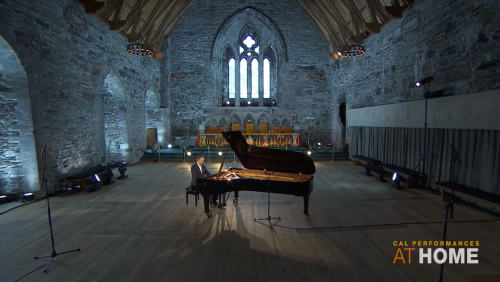 United States Various: Leif Ove Andsnes (piano), recorded at Håkon’s Hall, Bergen, Norway, 23.9.2020. Streamed by Cal Performances at Home, Berkeley, from 3.12.2020 to 3.1.2021. (HS)
United States Various: Leif Ove Andsnes (piano), recorded at Håkon’s Hall, Bergen, Norway, 23.9.2020. Streamed by Cal Performances at Home, Berkeley, from 3.12.2020 to 3.1.2021. (HS)

Mozart – Fantasia in C minor K.475
Beethoven – Piano Sonata in C minor Op.13 ‘Pathétique’
Janáček – Four selections from On an Overgrown Path, Book 1
Dvořák – Eight selections from Poetic Tone Pictures Op.85
Those looking for pianistic fire might find this program by Leif Ove Andsnes a bit tame, but the Norwegian maestro more than makes up for it with intelligence, subtlety and, yes, plenty of virtuosity.
Introducing the concert from outside Håkon’s Hall in Bergen, Norway, a thirteenth-century stone structure near his home, he adopts a welcoming tone and speaks of what the music means to him. He notes that the Mozart Fantasia in C minor and Beethoven ‘Pathétique’ Sonata are among the iconic works of classical piano, and that both are in C minor, a key chosen by composers when they have something important to say.
Inside the empty, church-like space – now a museum and often used for chamber music and choral concerts – the camera first lingers on the striking, soaring atmosphere. As the music unfolds, it focuses on Andsnes’s hands and face. Though he is in no hurry, there’s a sense of urgency, whether it’s the somber opening to the Mozart, the expressive introduction of the Beethoven or the later music in the second half.
He is aiming for clarity, not pyrotechnic effects. The music emerges burnished and alive under his touch. He can even be seen using the soft pedal in places not indicated in the score, but it adds to the purity of the sound. The music feels unforced.
The Mozart Fantasia begins with admirable restraint, and its sudden changes of direction feel more like subtle shifts than jarring bursts. The pace is absolutely right at every turn.
In the Beethoven, Andsnes draws connections between Beethoven and his predecessor. The opening measures feel fervent rather than stentorian, and the Allegro takes off at a rapid clip, deftly, almost Mozartean. The first movement finishes with enough restraint so that an audience, if there were one, would not be tempted to applaud, as often happens. The Adagio gets a soft touch, more contemplative than majestic, and the Rondo finale zips along merrily, landing at the finish without the usual rush.
Introducing the second half, Andsnes recalls that the teacher who most affected him was Czech. Even though the solo piano works of Dvořák and Janáček aren’t played as often as those by Schumann or Brahms, they made an impression on him.
We know Janáček best from his operas and big orchestral works. The four scenic miniatures from On an Overgrown Path, Book 1 (from 1911) travel mostly in folksy tunes, charming variations and only the occasional spicy harmony. Even ‘Come with us!’, meant to evoke children playing, bounces ever so gently. Andsnes starts the finale, ‘The Madonna of Frydek’, with supple tone for the chorale-like first measures, and garlands the repeats with sprinkles of piano runs executed with a feathery touch.
Eight of Dvořák’s Poetic Tone Pictures (from 1889) conclude the program with music of greater depth and diversity than the Janáček. Andsnes finds contrasts between the legato opening measures and pop-ups of quick melodic strands in ‘Nocturnal route’ and ‘Reverie’, and dances gracefully over a rhythmic base that feels remarkably like a tango. ‘Spring Song’ and ‘Serenade’ sound like Mendelssohn with a Czech accent, utterly magical. If the ‘Bacchanal’ is chaste enough to get a G rating, the final selection, ‘On the Holy Mountain’, makes the most of rapidly swirling filigree at the high end of the piano over soft chords at the middle and bottom.
The encore, Stravinsky’s Tango, injects a welcome rhythmic intensity to finish things off.
Harvey Steiman
Available on demand through 3 January 2021 (click here).
